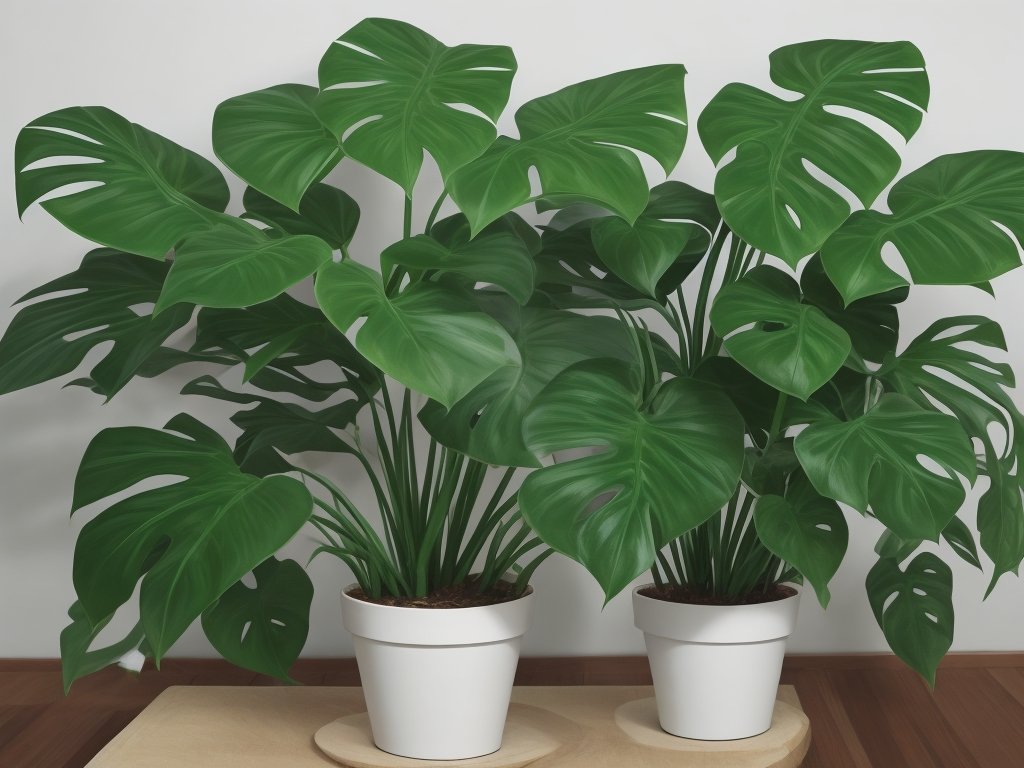Why Are The Leaves On My Monstera Plant Turning Yellow?
Key Takeaways:
- Yellow leaves on a Monstera plant may be due to overwatering or underwatering.
- Insufficient sunlight can also cause the leaves of a Monstera plant to turn yellow.
- Nutrient deficiencies, such as lack of iron or nitrogen, can contribute to yellowing leaves in a Monstera plant.
- Pests or diseases, such as spider mites or root rot, can be a cause of yellow leaves in a Monstera plant.
Are you worried about the yellow leaves on your beloved Monstera plant? Well, you’re not alone! It’s disheartening to see those vibrant green leaves lose their luster.
But fear not, my friend, because I’m here to shed some light on the matter.
In this article, we’ll explore the common reasons why your Monstera leaves turn yellow, ranging from lack of light to pest infestation. We’ll dive deep into each potential cause and provide you with practical tips on how to revive your plant back to its green glory.
So, let’s get to the root of the yellow leaf problem, shall we?
| Possible Causes | Solutions |
| 1. Overwatering | – Adjust watering frequency and amount – Ensure proper drainage – Allow soil to dry out between waterings |
| 2. Underwatering | – Increase watering frequency – Ensure soil is consistently moist (but not soggy) – Consider using a humidifier |
| 3. Nutrient deficiency | – Fertilize with a balanced houseplant fertilizer – Use a fertilizer specifically formulated for foliage plants – Follow the recommended dosage |
| 4. Excessive sunlight | – Place the plant in a location with bright, indirect light – Provide some shade during the hottest part of the day |
| 5. Drafts or temperature extremes | – Move the plant away from drafty areas – Maintain consistent room temperature (ideally between 60-75°F or 15-24°C) |
| Note: It’s important to assess the overall health of the plant and rule out any pests or diseases. |
Common Reasons for Yellow Leaves on Monstera Plants
The common reasons for yellow leaves on Monstera plants include lack of light, overwatering, underwatering, nutrient deficiency, and pest infestation.
Lack of Light
Lack of light is a common reason for yellow leaves on Monstera plants. Monstera plants require bright, indirect light to thrive.
Signs of insufficient light include pale leaves, leggy growth, and slow growth.
To provide adequate light, place your Monstera near a window with filtered sunlight or use artificial grow lights.
Overwatering
Overwatering is a common cause of yellow leaves on Monstera plants.
It can lead to root rot and hinder the plant’s ability to absorb nutrients.
Signs of overwatering include wilted leaves, yellowing, and root rot.
Ensure proper drainage and only water when the top inch of soil is dry.
Underwatering
Underwatering is a common cause of yellow leaves on Monstera plants. Signs include dry soil, wilting leaves, and leaf edges turning brown.
To avoid underwatering, make sure to water your Monstera plant thoroughly when the top inch of soil feels dry.
Don’t let it completely dry out, but also avoid overwatering.

Nutrient Deficiency
Nutrient deficiency can cause yellow leaves in Monstera plants.
The essential nutrients for Monstera plants include nitrogen, phosphorus, potassium, iron, and magnesium.
Signs of nutrient deficiency include pale or yellow leaves, stunted growth, and leaf discoloration.
To provide the right nutrients, use a balanced fertilizer specifically formulated for indoor plants and follow the instructions for application.
Pest Infestation
Pest infestation can cause yellow leaves on Monstera plants.
Common pests include spider mites, mealybugs, and scale insects.
Signs include tiny webs, sticky residue, or visible pests on the leaves.
Remove pests by wiping leaves with a damp cloth or using an insecticidal soap.
Lack of Light as a Cause of Yellow Leaves
If your Monstera plant’s leaves are turning yellow, it could be due to a lack of light.
Monstera Plant Light Requirements
Monstera plants thrive in bright, indirect light. They prefer a good balance between light and shade.
Place them near a window with filtered sunlight, or a few feet away from a bright, sunny window.
Direct sunlight can scorch their leaves, so it’s best to avoid placing them in full sun. If you notice your Monstera’s leaves turning yellow, it may indicate insufficient light.
Adjust its placement to provide more light, but avoid direct sunlight.

Signs of Insufficient Light
Signs of insufficient light for a Monstera plant include yellowing or pale leaves, slow growth, and a leggy appearance with elongated stems. The leaves may also become smaller in size and have a lack of variegation.
Adequate light is essential for healthy Monstera growth, so it’s important to provide the right conditions.

How to Provide Adequate Light
To provide adequate light for your Monstera plant, place it in a spot where it can receive bright, indirect sunlight.
Avoid placing it in direct sunlight as this can scorch the leaves.
If your plant doesn’t get enough natural light, you can supplement with artificial grow lights.
Keep an eye on the plant’s leaves and adjust the lighting as needed to prevent them from turning yellow.
Overwatering and Yellow Leaves
Overwatering can cause the leaves on your Monstera plant to turn yellow.
Monstera Plant Watering Needs
Monstera plants prefer moist but well-draining soil.
Water them when the top inch of soil feels dry.
Avoid overwatering, as it can lead to root rot and yellow leaves.
Ensure the pot has drainage holes, and use room temperature water.
Mist the leaves occasionally to increase humidity.
Signs of Overwatering
Signs of overwatering in Monstera plants include yellowing leaves, leaf drop, wilting, and root rot. You may notice that the leaves feel mushy or appear waterlogged.
The soil will also be consistently wet or soggy, and there may be a foul smell.
Adjust your watering routine to prevent overwatering and save your plant.
Underwatering and Yellow Leaves
If your Monstera plant leaves are turning yellow, it could be a sign of underwatering.
Keep an eye out for dry soil and adjust your watering routine accordingly.
Monstera Plant Watering Needs
To meet Monstera plant’s watering needs, keep the soil lightly moist during the growing season. Allow the top inch of soil to dry out before watering again.
Avoid overwatering, which can lead to root rot.
Regularly check the moisture levels by sticking your finger into the soil. Remember, it’s always better to underwater than overwater Monstera plants.
Signs of Underwatering
Signs of underwatering include dry soil, wilting leaves, curling or drooping foliage, and yellowing or browning of the lower leaves.
Another indication is when the plant becomes lighter in weight.
It’s crucial to water thoroughly and consistently to prevent these symptoms.
Tips for Proper Watering
To properly water your Monstera plant, make sure to follow these tips:
- Water thoroughly: Water the plant until the water drains out from the bottom of the pot. This ensures that the roots receive enough water.
- Check soil moisture: Before watering again, check the moisture level of the soil using your finger. If the top inch of soil is dry, it’s time to water again.
- Adjust watering frequency: The frequency of watering will depend on factors like the size of the pot, humidity, and temperature. Instead of sticking to a strict schedule, monitor the soil moisture and adjust watering accordingly.
- Avoid waterlogging: Ensure proper drainage in the pot to prevent water from sitting at the bottom. Standing water can lead to root rot and yellowing leaves.
- Use the right watering technique: Water the soil directly around the base of the plant, avoiding the leaves. This helps prevent fungal infections and encourages healthy root growth.
Nutrient Deficiency and Yellow Leaves
If the leaves on your Monstera plant are turning yellow, it could be a sign of nutrient deficiency.
Essential Nutrients for Monstera Plants
Monstera plants require three key essential nutrients for healthy growth: nitrogen, phosphorus, and potassium.
These nutrients are often found in balanced fertilizers specifically formulated for houseplants.
It’s important to provide these nutrients regularly to prevent nutrient deficiency, which can result in yellow leaves.
Signs of Nutrient Deficiency
Signs of nutrient deficiency in Monstera plants include yellowing leaves (especially between the veins), stunted growth, leaf curling, and leaf drop.
Other symptoms may include pale or discolored leaves, brown spots, or distorted leaf shape.
Regularly inspecting your plant and addressing any signs of nutrient deficiency is essential for its overall health.
How to Provide the Right Nutrients
To provide the right nutrients for your Monstera plant, you can follow these steps:
- Use a well-balanced fertilizer designed for houseplants.
- Apply the fertilizer according to the package instructions, usually every 4-6 weeks during the growing season.
- Make sure to water your plant before fertilizing to prevent root burn.
- Consider using a slow-release fertilizer for a more gradual release of nutrients.
- Monitor the health of your plant and look for signs of nutrient deficiency, such as yellowing leaves or stunted growth.
- If you notice any deficiencies, adjust your fertilizer schedule or consider using a specialized plant food that targets specific nutrients.
- Be cautious not to over-fertilize, as this can lead to nutrient burn and damage to the plant.
- Regularly inspect the soil pH and adjust it if necessary, as some plants have specific pH requirements for optimal nutrient absorption.
By providing the right nutrients, you can help your Monstera plant thrive and prevent yellowing leaves caused by nutrient deficiencies.
Pest Infestation and Yellow Leaves
Pest infestation can cause yellow leaves on your Monstera plant.
Common Pests Affecting Monstera Plants
Common pests affecting Monstera plants include spider mites, mealybugs, and aphids.
These pests can feed on the leaves and stems, causing damage and yellowing.
Regularly inspect your plant for signs of infestation, such as webbing, sticky residue, or small crawling insects.
Treat infestations with organic insecticidal soap or neem oil, following the instructions carefully to control and eliminate the pests.
Signs of Pest Infestation
Signs of pest infestation on your Monstera plant may include visible pests on the leaves or soil, such as aphids, mealybugs, or spider mites. You may also notice discolored or distorted leaves, sticky residue on the leaves, or small holes in the foliage.
Methods to Control Pests
To control pests on your Monstera plants, start by isolating any affected plants to prevent the infestation from spreading.
Next, inspect the plants regularly for signs of pests like spider mites, mealybugs, or scale insects.
If you spot any pests, you can use insecticidal soap or neem oil to treat them.
It’s important to follow the instructions on the product label and apply the treatment as recommended.
Additionally, you can manually remove pests by gently wiping the leaves with a damp cloth or using a soft-bristled brush.
Regularly cleaning the plant and keeping it free from debris can also help prevent pests.
Remember to water the plants properly and avoid overfertilizing, as stressed plants are more susceptible to pest infestations.
FAQs about Yellow Leaves on Monstera Plants
Can yellow leaves be saved?
Yes, yellow leaves can sometimes be saved depending on the cause. If the yellowing is due to lack of light, providing adequate light can help.
For overwatering or underwatering, adjusting the watering routine can improve leaf health.
Nutrient deficiency can be resolved by fertilizing properly. If the yellowing is caused by pests, controlling the infestation can save the leaves.
Final Verdict
Yellow leaves on Monstera plants can be caused by a variety of factors, including lack of light, overwatering, underwatering, nutrient deficiency, and pest infestation. To address these issues, it is important to understand the plant’s specific needs and provide adequate light, water, and nutrients accordingly.
Regularly inspecting the plant for signs of pests and taking appropriate measures to control them is also crucial.
Remember, addressing these issues promptly and providing the necessary care will help keep your Monstera plant healthy and vibrant.





